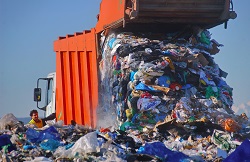Building bioplastics from waste streams
Whilst the market potential for environmentally friendly alternatives to fossil fuel-based plastics remains huge, cost remains a critical factor. ‘In order to become commercially viable, bioplastics need to compete in the same price range as petroleum-based plastics,’ explains SYNPOL project coordinator Prof. Jose Luis Garcia Lopez from the Spanish National Research Council. ‘One way of achieving this is to make use of already existing waste streams such as household waste that ends up in landfills, or sewage sludge from water treatment plants.’ Another important benefit here is that European countries spend a lot of money in transporting municipal waste many miles out of cities or states to be landfilled, leading to long-term environmental problems. Valorising this waste would save local authorities money, in addition to benefitting the environment and providing a boost to the waste conversion industry. Tapping benefits of biowaste The key success of the EU-funded SYNPOL project has been to capitalise on this opportunity by developing a viable process to efficiently turn waste into biopolymers. The system works by converting complex biowaste into syngas, which is then fed into a bioreactor for bacterial fermentation. This creates polyhydroxyalkanotates (PHAs) and building blocks for novel biopolymers. Researchers found that straw was the most promising raw material for producing syngas. Impressive progress was also made during the project in optimising the fermentation product yield by microorganisms. ‘This process will help to reduce landfill waste as well as the harmful impact of petrochemical plastics by offering a viable alternative,’ says Garcia. In addition, the syngas fermentation technology opens up new possibilities for converting a range of industrial biowastes. This will strengthen links along the supply chain (between producers and waste converters for example) and create new opportunities in food production, pharmaceuticals, packaging industries and recycling. Indeed, some biopolymer products developed by SYNPOL partners are already on their way to the market. ‘For example, an Irish SME project partner is producing a biodegradable biopolymer that can be used as film for packaging applications,’ says Garcia. ‘Another polymer prototype can be used to create scaffolds for biomedical applications.’ In addition, new technologies to polymerise PHAs by chemical and enzymatic procedures have been developed by various SYNPOL consortium partners with a view to securing patents. ‘The technology transfer office of the Spanish National Research Council is currently trying to extend and licence two patents that have been derived from the SYNPOL project so far,’ says Garcia. ‘One of the two patent applications is about a novel microwave-induced pyrolysis technique for organic waste conversion to syngas and the other concerns aerobic CO metabolism in microorganisms.’ A long term investment Completed in September 2016, the SYNPOL project underlines how investment in sustainable production processes can bring both economic and environmental benefits. The project has shown how waste streams can be exploited to produce biopolymer building blocks, reducing Europe’s need for both landfill space and plastics based on fossil fuels. There is potential for this pioneering fermentation technology to be applied to other complex waste streams in order to produce new biopolymers and other high added value compounds. ‘The project findings will be continued through the EU-funded CELBICON and upcoming ENGICOIN projects,’ says Garcia. ‘In both projects, collaboration with chemical engineers will bring the bacterial gas fermentation process closer to the industrial scale. Many project partners are also keen to further develop SYNPOL’s bacterial syngas fermentation process through future projects and networks.
Keywords
SNYPOL, waste, bioplastics, syngas, fermentation, biopolymers, PHAs







